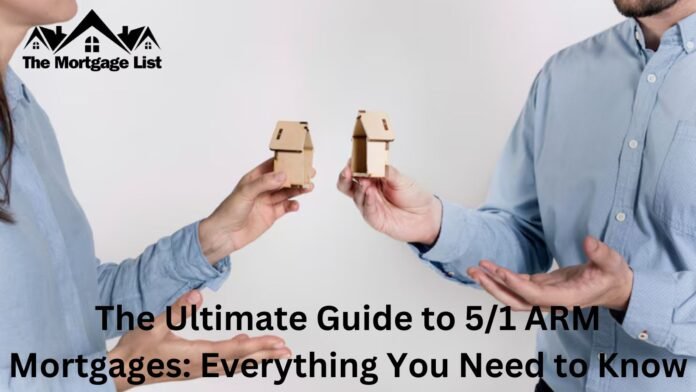The Ultimate Guide to 5/1 ARM Mortgages: Everything You Need to Know
What if I told you there’s a mortgage option that offers lower initial payments but comes with the potential for future rate adjustments? Enter the 5/1 ARM mortgage. This type of mortgage is a bit of a mystery to many, yet it’s an excellent choice for certain homeowners. Understanding the 5/1 ARM mortgage can help you make a more informed decision about whether it’s the right fit for you. So, let’s dive into the world of 5/1 ARM mortgages.
Understanding the Basics
Definition of 5/1 ARM
A 5/1 ARM, or Adjustable-Rate Mortgage, is a type of home loan where the interest rate is fixed for the first five years, and then it adjusts annually. The “5” represents the number of years the initial interest rate remains fixed, and the “1” indicates that the rate adjusts once per year after that period.
How It Works
For the first five years, you’ll enjoy the stability of a fixed-rate mortgage, often at a lower rate than a traditional fixed-rate mortgage. After that, the interest rate can fluctuate based on the market conditions, potentially changing your monthly payment amount.
Pros and Cons of 5/1 ARM Mortgages
Benefits
- Lower Initial Interest Rates: Typically, 5/1 ARMs offer lower rates for the first five years compared to fixed-rate mortgages.
- Potential for Lower Payments: Lower initial rates mean you could save money in the short term.
- Flexibility: If you plan to move or refinance within five years, a 5/1 ARM can be an advantageous choice.
Drawbacks
- Rate Increases: After the initial period, your interest rate can increase, which may lead to higher monthly payments.
- Uncertainty: The variability of future payments can be unsettling for some homeowners.
- Complexity: Understanding the terms and conditions of ARM mortgages can be more complicated than fixed-rate options.

Interest Rates and Adjustments
Initial Fixed Rate Period
During the first five years, your interest rate remains constant, providing predictability in your monthly payments.
Adjustment Periods
After five years, the rate adjusts annually based on the index it’s tied to, plus a set margin. These adjustments can either increase or decrease your payments depending on the market conditions.
Who Should Consider a 5/1 ARM Mortgage?
Ideal Candidates
- Short-Term Homeowners: Those planning to sell or refinance before the adjustment period starts.
- Professionals Expecting Income Growth: Individuals who anticipate significant salary increases may benefit from lower initial payments.
- Investors: Property investors who plan to flip the house within five years.
Situations Where It Makes Sense
If you’re confident about moving or refinancing within five years, or if you can handle potential increases in your mortgage payments, a 5/1 ARM could be a smart financial move.
Comparison with Other Mortgage Types
5/1 ARM vs. Fixed-Rate Mortgages
- Fixed-Rate Mortgages: Offer stability with a constant interest rate and predictable payments throughout the loan term.
- 5/1 ARM: Provides lower initial rates but comes with the risk of future rate adjustments.
5/1 ARM vs. Other Adjustable-Rate Mortgages
- 7/1 ARM or 10/1 ARM: Similar structure but with longer fixed-rate periods, which might be preferable for those seeking a balance between lower initial rates and longer stability.
How to Qualify for a 5/1 ARM Mortgage
Credit Score Requirements
Typically, a good to excellent credit score is required to qualify for a 5/1 ARM, similar to other mortgage types.
Income and Employment Verification
Lenders will check your income and employment history to ensure you have a stable financial background capable of handling potential payment increases.

Understanding the Index and Margin
Explanation of Index
The index is a benchmark interest rate that reflects general market conditions. Common indices include the LIBOR, COFI, or the One-Year Treasury.
What is the Margin?
The margin is a fixed percentage added to the index rate to determine the new interest rate during adjustments. This margin remains constant throughout the loan term.
How Adjustments Affect Your Monthly Payments
Impact on Budget
When the initial fixed-rate period ends, your monthly payments could increase significantly, impacting your budget. It’s crucial to plan for these changes to avoid financial strain.
Preparing for Rate Changes
Consider saving the difference between your 5/1 ARM payment and what you would pay with a fixed-rate mortgage to build a buffer for potential increases.
Prepayment and Refinancing Options
Advantages of Prepayment
Paying off your mortgage ahead of schedule can save you money on interest, particularly if you do so before the rate adjusts.
Refinancing to a Fixed Rate
If you anticipate staying in your home longer than expected, refinancing to a fixed-rate mortgage can provide stability and protect you from future rate hikes.
Risks Associated with 5/1 ARM Mortgages
Market Volatility
Economic changes can lead to increased interest rates, affecting your mortgages payments. Understanding this risk is essential before committing to a 5/1 ARM.
Payment Shock
A significant rise in interest rates can lead to “payment shock,” where your monthly payment jumps to an unaffordable level. This can be mitigated with careful financial planning and savings.
Strategies for Managing a 5/1 ARM Mortgage
Budgeting Tips
Create a budget that includes potential rate increases. This can help you manage your finances more effectively when adjustments occur.
Financial Planning
Work with a financial advisor to develop a plan that accommodates possible rate hikes and ensures you can handle increased payments.
Case Studies and Examples
Real-Life Scenarios
- Young Professional: Bought a home with a 5/1 ARM, then moved for a job opportunity within five years, benefiting from lower initial payments.
- Investor: Used a 5/1 ARM to finance a property flip, selling before the rate adjusted and maximizing profit.
Lessons Learned
These examples highlight the importance of aligning your mortgages choice with your financial goals and future plans.
Common Misconceptions
Myths vs. Reality
- Myth: 5/1 ARMs are only for risky borrowers. Reality: They can be a strategic choice for financially savvy individuals.
- Myth: You will always end up paying more. Reality: If used correctly, you can save money and manage the risks.
Clarifying Common Questions
Understanding how 5/1 ARMs work can dispel many misconceptions and help you see if this mortgage type suits your needs.

Conclusion
In summary, a 5/1 ARM mortgages offers lower initial payments and can be a great fit for certain homeowners. However, it’s crucial to understand the risks and be prepared for future rate adjustments. Whether you’re a short-term homeowner, expecting significant income growth, or an investor, a 5/1 ARM can be a valuable tool in your financial arsenal. Always consider your long-term plans and financial stability when choosing a mortgage to ensure it aligns with your goals.
FAQs
- What happens if I can’t afford the payments after the rate adjusts? If you’re worried about future payments, consider refinancing to a fixed-rate mortgage before the adjustment period begins.
- Can I refinance a 5/1 ARM? Yes, you can refinance a 5/1 ARM to a fixed-rate mortgages or another ARM with different terms.
- Is a 5/1 ARM a good option for first-time homebuyers? It can be, especially if you plan to move or refinance within five years and want to take advantage of lower initial rates.
- How often can the interest rate change after the initial period? The interest rate can change annually after the initial five-year fixed period.
- What is the maximum amount my interest rate can increase? This depends on the terms of your loan, but ARMs usually have caps that limit how much the rate can increase at each adjustment and over the life of the loan.
Read More:>

